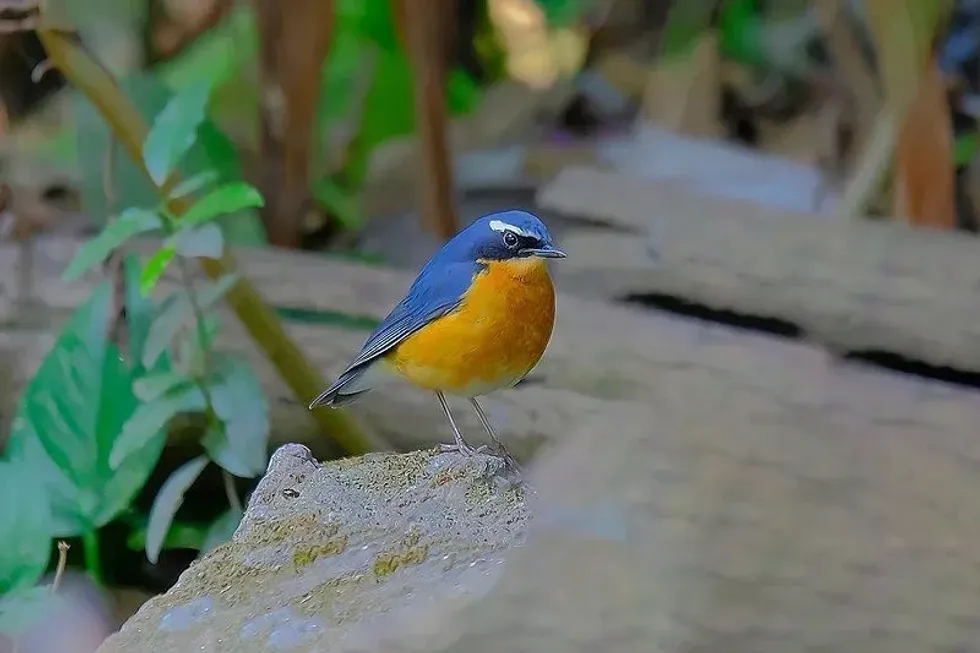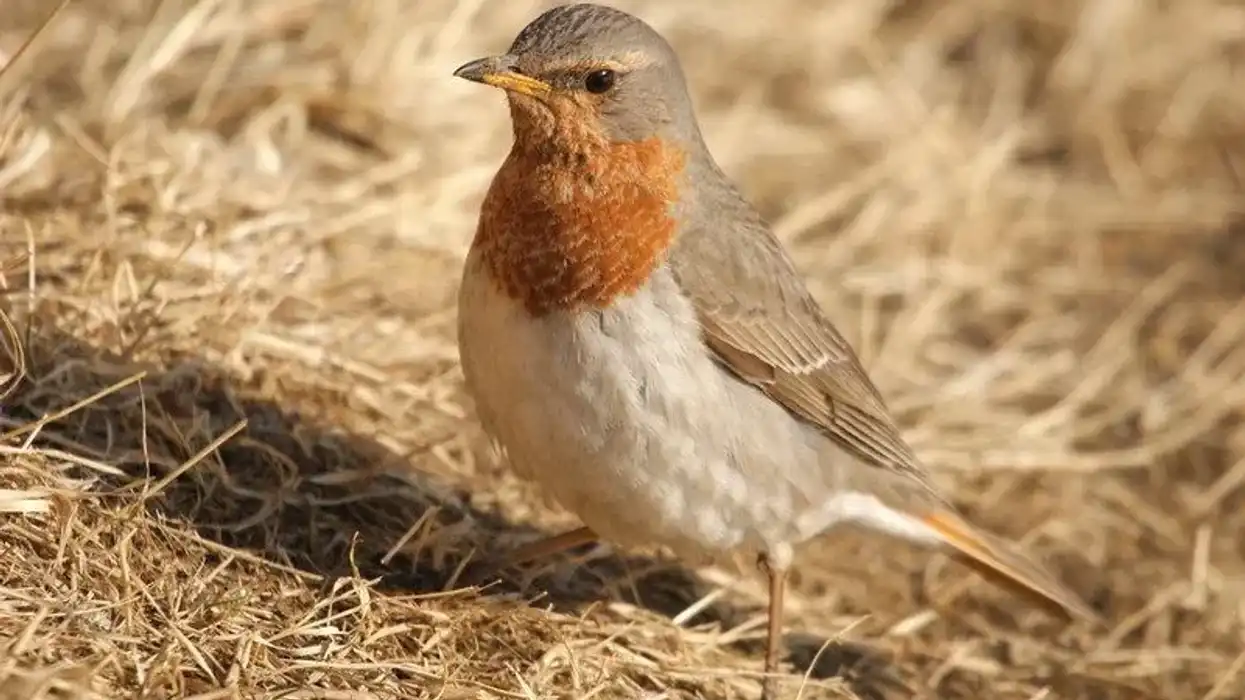The Indian blue robin is a small bird whose scientific name is Larvivora brunnea. The bird is most commonly found in the Indian subcontinent of South Asia, as its name suggests, and is considered one among many other birds from the Old World flycatchers under the family of Muscicapidae.
It was originally considered a thrush but was later on separated from them.
The bird is also called the Indian blue chat and is migratory in nature.
It is typically found in the forests of the Himalayas, Myanmar, Bangladesh, Nepal, Sri Lanka, and around the Western Ghats of India. Their breeding grounds consist of the Indian subcontinent and its neighbors, except for Sri Lanka and the Western Ghats where they are typically found during winter.
As far as appearances go, it is a small bird with bright blue colors. An adult male Indian robin has a blue body with a bright white supercilium, contrasting with a black mask along its neck whereas the female is usually olive-brown in color.
They usually feed on insects and love beetles and worms along with fruits, berries, seeds, and nuts found around their habitat.
If you enjoy reading about birds, then check out these European robin facts and great tit facts!
Indian Blue Robin Interesting Facts
What type of animal is an Indian blue robin?
The Indian blue robin (Larvivora brunnea) is a type of bird from the family of Larvivora under the animal kingdom.
What class of animal does an Indian blue robin belong to?
The Indian blue robin (Larvivora brunnea) belongs to the Aves class of animals.
How many Indian blue robins are there in the world?
The present population count of the Indian blue robin (Larvivora brunnea) is unknown. According to reports, there has been a decline in their population trend but there is no evident fluctuation in their overall population size.
Where does an Indian blue robin live?
An Indian blue robin (Larvivora brunnea) is typically found in the mountain regions of the Himalayan range in the Indian subcontinent. Birds prefer living in the hill forests, mountains, terrestrial forests, dense bushes, woodlands, shrublands, parks, and gardens with low vegetation and favorable climatic as well as breeding conditions.
What is an Indian blue robin's habitat?
An Indian blue robin's (Larvivora brunnea) habitat consists of the regions of the Indian Himalayas, Nepal, Myanmar, Bangladesh, and the Ghats of southwest India where the birds are usually around low vegetation areas near the ground.
They are also found living in large fir trees or in the dark and dense forest with an abundance of leaf litter and undergrowth.
Who do Indian blue robins live with?
Indian blue robins (Larvivora brunnea) tend to stay with their partners so they are usually seen in pairs but being social birds, they move around with their flocks during the breeding season and defend their nesting areas together.
How long does an Indian blue robin live?
The average life expectancy of an Indian blue robin (Larvivora brunnea) is estimated to be about one to two years.
How do they reproduce?
The breeding season begins around May-July where the birds begin their mating rituals by fanning and flipping their tails to attract their mates. Once the ritual is done, their nests are made on low elevation ground surrounded by vegetation.
The nest is made with the help of roots, twigs, and leaves where a place of depression is kept for the eggs to be laid. The female usually lays about three to four eggs that are light blue in color and incubates them until they are hatched.
What is their conservation status?
Although there has been a decline in the Indian blue chat population trend, it has no extreme threats to its existence and falls under the Least Concern classification according to the IUCN Red List.
Indian Blue Robin Fun Facts
What do Indian blue robins look like?

The Indian blue robin (Larvivora brunnea) is a small-sized bird, similar to a bluethroat, growing up to a length of 5.90 in (15 cm). The adult is a stunning bright-blue species with blue underparts and upperparts with a mixture of a white and bright-orange tail and belly.
The birds have a long white supercilium starting from the eye to its neck with a black eye mask that covers the parts around its eyes.
Unlike males, females are paler in color with a brown appearance and buff underparts. The throat and belly are white in color. As for the young ones, they are similar to the females and have brown scaly plumage.
How cute are they?
The small Indian blue robin (Luscinia brunnea) is very cute in appearance as well as in its social behavior with its sweet voice and adorable feathers. Anyone who looks at them will wish to hold and cherish them.
How do they communicate?
They are loud in nature and communicate vocally through various calls and songs. Although their songs are usually melodious, their calls consist of a sharp and sudden series of whistles, which sometimes end in abrupt notes, along with low sharp yet strong clicking alarm notes.
How big is an Indian blue robin?
An Indian blue robin (Luscinia brunnea) grows up to a maximum length of 5.90 in (15 cm).
How fast can an Indian blue robin fly?
The average speed of the Indian blue robin (Luscinia brunnea) speed of flight is estimated to be about 20-36 mph (32-58 kph).
How much does an Indian blue robin weigh?
The average weight of an Indian blue robin (Luscinia brunnea) is around 0.49-0.74 oz (14-21 g).
What are the male and female names of the species?
There are no sex-specific names given to Indian blue robin (Luscinia brunnea).
What would you call a baby Indian blue robin?
A baby Indian blue robin (Luscinia brunnea) is referred to as a chick like many other species of birds.
What do they eat?
A Robin's diet consists of insects, worms, fruits, berries, seeds, and nuts whereas predators like snakes, squirrels, cats, and other large birds such as hawks, crows, jays, owls, and shrikes consider them as food.
Are they dangerous?
Not at all. Indian blue robins are adorable creatures who mind their own business and do not inflict any kind of harm.
Would they make a good pet?
Yes, an Indian blue robin (Luscinia brunnea) with its adorable size, appearance, and good social behavior would make a wonderful pet.
Did you know...
The Indian blue robin (Luscinia brunnea) is among the few bird species that can recognize a human face! They can recognize your appearance, gestures, voice, and even movements.
As per studies, birds like hooded crows and guillemot pigeons can recognize human faces and can hold grudges against you if they do not like you. Robins are included in that list, but they will follow you if they feel safe around you and appreciate it if you give them food.
Is the Indian blue robin a migratory bird?
Yes, the Indian blue robin (Luscinia brunnea) is a migratory breeding bird that usually starts its migration journey in September. They travel across all over Peninsular India during winters where they are usually found in the hilly regions of Southern India, Western Ghats, and Sri Lanka.
Around mid-September, they leave their winter grounds and migrate to other areas with dark forests where they sing their hearts out.
What type of bird is the Indian blue robin?
The Indian blue robin (Luscinia brunnea) was formally considered a subspecies of thrush but were recently divided from the thrush and put under the family of Muscicapidae, among one of the old world flycatchers.
The separation was done on the basis of molecular phylogenetic studies of the bird species for the family of Muscicapidae that proved the bird's origin.
Here at Kidadl, we have carefully created lots of interesting family-friendly animal facts for everyone to discover! Learn more about some other birds from our Blackburnian warbler facts and Hawaiian honeycreeper facts for kids.
You can even occupy yourself at home by coloring in one of our free printable Indian blue robin bird coloring pages.









